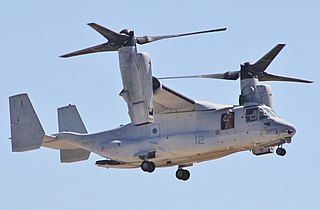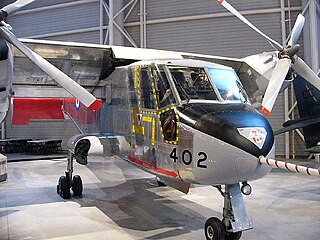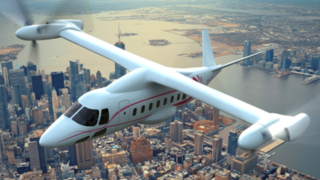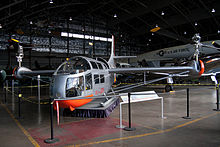
A vertical take-off and landing (VTOL) aircraft is one that can take off and land vertically without relying on a runway. This classification can include a variety of types of aircraft including helicopters as well as thrust-vectoring fixed-wing aircraft and other hybrid aircraft with powered rotors such as cyclogyros/cyclocopters and gyrodynes.

The Bell Boeing V-22 Osprey is an American multi-mission, tiltrotor military aircraft with both vertical takeoff and landing (VTOL) and short takeoff and landing (STOL) capabilities. It is designed to combine the functionality of a conventional helicopter with the long-range, high-speed cruise performance of a turboprop aircraft. The V-22 is operated by the United States and Japan, and is not only a new aircraft design, but a new type of aircraft that entered service in the 2000s, a tiltrotor compared to fixed wing and helicopter designs. The V-22 first flew in 1988 and after a long development was fielded in 2007. The design essentially combines the vertical takeoff ability of a helicopter, but the range of a fixed-wing airplane.

A tiltrotor is an aircraft that generates lift and propulsion by way of one or more powered rotors mounted on rotating shafts or nacelles usually at the ends of a fixed wing. Almost all tiltrotors use a transverse rotor design, with a few exceptions that use other multirotor layouts.

The Bell XV-15 is an American tiltrotor VTOL aircraft. It was the second successful experimental tiltrotor aircraft and the first to demonstrate the concept's high speed performance relative to conventional helicopters.

The Leonardo AW609, formerly the AgustaWestland AW609, and originally the Bell/Agusta BA609, is a twin-engined tiltrotor VTOL aircraft with an overall configuration similar to that of the Bell Boeing V-22 Osprey. It is capable of landing vertically like a helicopter while having a range and speed in excess of conventional rotorcraft. The AW609 is aimed at the civil aviation market, in particular VIP customers and offshore oil and gas operators. It has progressed from a concept in the late 1990s, to development and testing, and is working towards certification in the 2020s.

The Bell X-22 is an American V/STOL X-plane with four tilting ducted fans. Takeoff was to selectively occur either with the propellers tilted vertically upwards, or on a short runway with the nacelles tilted forward at approximately 45°. Additionally, the X-22 was to provide more insight into the tactical application of vertical takeoff troop transporters such as the preceding Hiller X-18 and the X-22's successor, the Bell XV-15. Another program requirement was a true airspeed in level flight of at least 525 km/h.

The Lockheed AH-56 Cheyenne is an attack helicopter developed by Lockheed for the United States Army. It rose from the Army's Advanced Aerial Fire Support System (AAFSS) program to field the service's first dedicated attack helicopter. Lockheed designed the Cheyenne using a four-blade rigid-rotor system and configured the aircraft as a compound helicopter with low-mounted wings and a tail-mounted thrusting propeller driven by a General Electric T64 turboshaft engine. The Cheyenne was to have a high-speed dash capability to provide armed escort for the Army's transport helicopters, such as the Bell UH-1 Iroquois.

The Canadair CL-84 "Dynavert", designated by the Canadian Forces as the CX-131, was a V/STOL turbine tiltwing monoplane designed and manufactured by Canadair between 1964 and 1972. Only four of these experimental aircraft were built with three entering flight testing. Two of the CL-84s crashed due to mechanical failures, with no fatalities occurring in either of the accidents. Despite the CL-84 being successful in the experimental and operational trials carried out between 1972 and 1974, none of the prospective customers placed any orders for the type.

A tip jet is a jet nozzle at the tip of some helicopter rotor blades, used to spin the rotor, much like a Catherine wheel firework. Tip jets replace the normal shaft drive and have the advantage of placing no torque on the airframe, thus not requiring the presence of a tail rotor. Some simple monocopters are composed of nothing but a single blade with a tip rocket.
A convertiplane is defined by the Fédération Aéronautique Internationale as an aircraft which uses rotor power for vertical takeoff and landing (VTOL) and converts to fixed-wing lift in normal flight. In the US it is further classified as a sub-type of powered lift. In popular usage it sometimes includes any aircraft that converts in flight to change its method of obtaining lift.

The Sikorsky S-72 was an experimental Sikorsky Aircraft compound helicopter developed as the Rotor Systems Research Aircraft (RSRA) for the National Aeronautics and Space Administration (NASA) and the United States Army. The RSRA was a testbed for rotor and propulsion systems for high-speed.

The Bell Boeing Quad TiltRotor (QTR) is a proposed four-rotor derivative of the Bell Boeing V-22 Osprey developed jointly by Bell Helicopter and Boeing. The concept is a contender in the U.S. Army's Joint Heavy Lift program. It would have a cargo capacity roughly equivalent to the C-130 Hercules, cruise at 250 knots, and land at unimproved sites vertically like a helicopter.

A powered lift aircraft takes off and lands vertically under engine power but uses a fixed wing for horizontal flight. Like helicopters, these aircraft do not need a long runway to take off and land, but they have a speed and performance similar to standard fixed-wing aircraft in combat or other situations.

A proprotor is a spinning airfoil that function as both an airplane-style propeller and a helicopter-style rotor. Several proprotor-equipped convertiplanes, such as the Bell Boeing V-22 Osprey tiltrotor, are capable of switching back and forth between flying akin to both helicopters and fixed-wing aircraft. Accordingly this type of airfoil has been predominantly applied to vertical takeoff and landing (VTOL) aircraft.

The McDonnell XV-1 is an experimental Convertiplane developed by McDonnell Aircraft for a joint research program between the United States Air Force and the United States Army to explore technologies to develop an aircraft that could take off and land like a helicopter but fly at faster airspeeds, similar to a conventional airplane. The XV-1 would reach a speed of 200 mph, faster than any previous rotorcraft, but the program was terminated due to the tip-jet noise and complexity of the technology which gave only a modest gain in performance.

The AgustaWestland Project Zero is a hybrid tiltrotor/Lift fan aircraft. It has been developed by AgustaWestland as a technology demonstrator, and is used to investigate all-electric propulsion and other advanced technologies. It is the world's first electric tiltrotor aircraft.

The Transcendental Model 1-G was an experimental American tiltrotor prototype of the 1950s. It was a single-seat aircraft powered by a piston engine, and was the first tiltrotor to fly. A single example was built, which was destroyed in a crash in 1955.

The Bell V-247 Vigilant is a concept by Bell Helicopter to develop a large tiltrotor unmanned aerial vehicle.

The Leonardo Next-Generation Civil Tiltrotor is a tiltrotor aircraft demonstrator designed and developed by the Italian aerospace company Leonardo S.p.A. Studies for a two times larger tiltrotor than the AgustaWestland AW609 started in 2000. Since 2014, its development is sponsored by the European Union's Clean Sky 2 program. By May 2021, major components were under production By 2023, the maiden flight had been pushed back to 2024, from a 2020 initial plan.
























